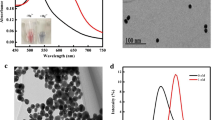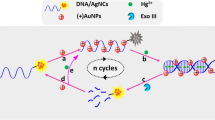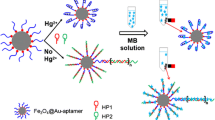Abstract
A method is described for sensitive colorimetric determination of zinc(II) ions that uses (a) a Zn(II)-responsive hairpin DNAzyme that assists target recycling, (b) hybridization chain reaction, and (c) hemin/G-quadruplex DNA nanoladder. The Zn(II)-responsive split of the hairpin DNAzyme (HD) acts as the recognition and transformation probe. Upon addition of Zn (II) and enzyme strand, a duplex is formed in the loop region of hairpin. The caged initiator sequence is subsequently liberated from the HD by the Zn(II)-selective split of the substrate strand. This cleavage induces an enzyme strand recycling for the next round of cleavage. As a result, the initiator DNA is accumulated and cross-opened H1 and H2 to start a hybridization chain reaction (HCR). The caged G-quadruplex is released after the HCR to recruit hemin to form the hemin/G-quadruplex that is inserted into the DNA nanoladder. Once formed in the DNA nanoladder, these act as catalytic labels for the ABTS, resulting a green color change. This cascade amplification strategy allows 10 nM to 100 μM of Zn(II) to be linearly quantified by colorimetry at 415 nm with a detection limit of 3.5 nM. The recoveries ranged from 97.7 to 108.3% were obtained, confirming high reliability of the method for Zn2+ analysis in lake water samples.

A colorimetric assay for Zn2+ using hairpin DNAzyme (HD) assistant cycle and hemin/G-quadruplex lighted nanoladders is designed. A Zn2+-responsive split of HD is designed as the recognition and transformation probe. The hemin/G-Quadruplex inserted nanoladder act as reporter for signal readout.






Similar content being viewed by others
References
Assaf SY, Chung SH (1984) Release of endogenous Zn2+ from brain-tissue during activity. Nature 308:734–736
Duan JX, Nilsson L (2006) Effect of Zn2+ on DNA recognition and stability of the p53 DNA-binding domain. Biochemistry-Us 45:7483–7492
Einicker-Lamas M, Mezian GA, Fernandes TB, Silva FLS, Guerra F, Miranda K, Attias M, Oliveira MM (2002) Euglena gracilis as a model for the study of Cu2+ and Zn2+ toxicity and accumulation in eukaryotic cells. Environ Pollut 120:779–786
Weiss JH, Sensi SL, Koh JY (2000) Zn2+: a novel ionic mediator of neural injury in brain disease. Trends Pharmacol Sci 21:395–401
Pagani A, Villarreal L, Capdevila M, Atrian S (2007) The Saccharomyces cerevisiae Crs5 Metallothionein metal-binding abilities and its role in the response to zinc overload. Mol Microbiol 63:256–269
Wyszkowska J, Borowik A, Kucharski M, Kucharski J (2013) Effect of cadmium, copper and zinc on plants, soil microorganisms and soil enzymes. J Elem 18:769–796
Wilner OI, Willner I (2012) Functionalized DNA nanostructures. Chem Rev 112:2528–2556
Zhang F, Yan H (2017) Nanotechnology: DNA self-assembly scaled up. Nature 552:185
Sakamoto K, Gouzu H, Komiya K, Kiga D, Yokoyama S, Yokomori T, Hagiya M (2000) Molecular computation by DNA hairpin formation. Science 288:1223–1226
Turberfield AJ, Mitchell JC, Yurke B, Mills AP, Blakey MI, Simmel FC (2003) DNA fuel for free-running nanomachines. Phys Rev Lett 90:118102
Hou L, Wu XP, Chen GN, Yang HH, Lu MH, Tang DP (2015) HCR-stimulated formation of DNAzyme concatamers on gold nanoparticle for ultrasensitive impedimetric immunoassay. Biosens Bioelectron 68:487–493
Yang XJ, Yu YB, Gao ZQ (2014) A highly sensitive Plasmonic DNA assay based on triangular silver Nanoprism etching. ACS Nano 8:4902–4907
Huang J, Wu YR, Chen Y, Zhu Z, Yang XH, Yang CJ et al (2011) Pyrene-Excimer probes based on the hybridization chain reaction for the detection of nucleic acids in complex biological fluids. Angew Chem Int Ed 50:401–404
Chemeris DA, Nikonorov YM, Vakhitov VA (2008) Real-time hybridization chain reaction. Dokl Biochem Biophys 419:53–55
Niu SY, Jiang Y, Zhang SS (2010) Fluorescence detection for DNA using hybridization chain reaction with enzyme-amplification. Chem Commun 46:3089–3091
Wang F, Elbaz J, Orbach R, Magen N, Willner I (2011) Amplified analysis of DNA by the autonomous assembly of polymers consisting of DNAzyme wires. J Am Chem Soc 133:17149–17151
Shimron S, Wang F, Orbach R, Willner I (2012) Amplified detection of DNA through the enzyme-free autonomous assembly of Hemin/G-Quadruplex DNAzyme nanowires. Anal Chem 84:1042–1048
Miao M, Tian JJ, Luo YB, Du ZH, Liang ZH, Xu WT (2018) Terminal deoxynucleotidyl transferase-induced DNAzyme nanowire sensor for colorimetric detection of lipopolysaccharides. Sensors Actuators B Chem 256:790–796
Wang YH, Jiang L, Leng QG, Wu YH, He XX, Wang KM (2016) Electrochemical sensor for glutathione detection based on mercury ion triggered hybridization chain reaction signal amplification. Biosens Bioelectron 77:914–920
Wang CK, Dong XY, Liu Q, Wang K (2015) Label-free colorimetric aptasensor for sensitive detection of ochratoxin a utilizing hybridization chain reaction. Anal Chim Acta 860:83–88
Wang XZ, Jiang AW, Hou T, Li HY, Li F (2015) Enzyme-free and label-free fluorescence aptasensing strategy for highly sensitive detection of protein based on target-triggered hybridization chain reaction amplification. Biosens Bioelectron 70:324–329
Guo JJ, Wang JC, Zhao JQ, Guo ZL, Zhang YZ (2016) Ultrasensitive multiplexed immunoassay for tumor biomarkers based on DNA hybridization chain reaction amplifying signal. ACS Appl Mater Interfaces 8:6898–6904
Wang Q, Yang XH, Yang XH, Liu P, Wang KM, Huang J et al (2015) Colorimetric detection of mercury ion based on unmodified gold nanoparticles and target-triggered hybridization chain reaction amplification. Spectrochim Acta A 136:283–287
Li ZB, Miao XM, **ng K, Peng X, Zhu AH, Ling LS (2016) Ultrasensitive electrochemical sensor for Hg2+ by using hybridization chain reaction coupled with Ag@Au core-shell nanoparticles. Biosens Bioelectron 80:339–343
Li Y, And CRG, Sen D (1996) Recognition of anionic porphyrins by DNA aptamers. Biochemistry 35:6911–6922
Li YF, Geyer CR, Sen D (1996) Recognition of anionic porphyrins by DNA aptamers. Biochemistry-Us 35:6911–6922
Pavlov V, **ao Y, Gill R, Dishon A, Kotler M, Willner I (2004) Amplified chemiluminescence surface detection of DNA and telomerase activity using catalytic nucleic acid labels. Anal Chem 76:2152–2156
Zhou XH, Kong DM, Shen HX (2010) G-quadruplex-hemin DNAzyme-amplified colorimetric detection of Ag+ ion. Anal Chim Acta 678:124–127
Naijie **g RFR, Yves Pommier A, MEH (1997) Ion selective folding of loop domains in a potent anti-HIV oligonucleotide. Biochemistry 36:12498–12505
Li YF, Sen D (1996) A catalytic DNA for porphyrin metallation. Nat Struct Biol 3:743–747
Ellington AD, Szostak JW (1990) Invitro selection of Rna molecules that bind specific ligands. Nature 346:818–822
Xu JC, Sun YH, Sheng YJ, Fei YQ, Zhang J, Jiang DZ (2014) Engineering a DNA-cleaving DNAzyme and PCR into a simple sensor for zinc ion detection. Anal Bioanal Chem 406:3025–3029
Rajendran M, Ellington AD (2008) Selection of fluorescent aptamer beacons that light up in the presence of zinc. Anal Bioanal Chem 390:1067–1075
Guo YH, Sun Y, Shen XQ, Chen X, Yao WR, **e YF et al (2015) Quantification of Zn(II) using a label-free sensor based on graphene oxide and G-quadruplex. Anal Methods 7:9615–9618
Acknowledgments
This work is financially supported by the major science and technology project to create new crop varieties using gene transfer technology” (2018ZX0801102B-002) and the National Natural Science Foundation of China (No.31801626, No.31871875).
Author information
Authors and Affiliations
Corresponding author
Ethics declarations
Conflict of interest
The authors declare no competing financial interests.
Additional information
Publisher’s note
Springer Nature remains neutral with regard to jurisdictional claims in published maps and institutional affiliations.
Electronic supplementary material
ESM 1
(DOCX 22 kb)
Rights and permissions
About this article
Cite this article
Zhu, L., Li, G., Shao, X. et al. A colorimetric zinc(II) assay based on the use of hairpin DNAzyme recycling and a hemin/G-quadruplex lighted DNA nanoladder. Microchim Acta 187, 26 (2020). https://doi.org/10.1007/s00604-019-3996-2
Received:
Accepted:
Published:
DOI: https://doi.org/10.1007/s00604-019-3996-2




